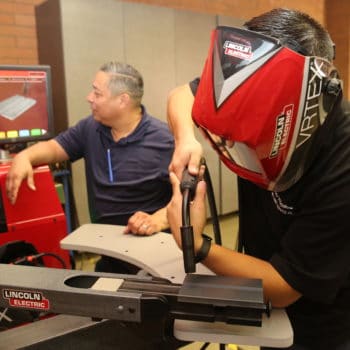
It’s not all that uncommon to hear cheers and commentary emanating from welding classrooms at either Local 359 in Phoenix or Local 100 near Washington, D.C. Where at many schools, welders learn one-on-one with their instructor in a quiet booth, apprentices at these two schools begin their welding educations on a virtual welder.
Equipped with technology similar to first-person style, virtual reality video games, the virtual welder creates a job site environment (there are a few to choose from) with real sounds, light and sparks. The welding helmet is equipped with virtual reality glasses that allow the student to look around in any direction. The screen allows the instructor — or in Local 100’s case, the whole class — to follow along and correct the student. After the weld, the performance is reviewed and scored.
This new technology, for a typically video game-savvy crowd, isn’t lost on training coordinators and business managers facing welding shortages and recruiting challenges.
“The students are motivated to get on the machine because it looks like a game,” said Al Blanco, training coordinator at Local 359, which received its first virtual welder last summer. “It turns into a competition. Having that game aspect, I think it’ll get people back into welding.”
Local 100 instructors hooked up a 50-inch flat-screen television to the welder to make learning a group experience.
“You can actually teach a class better because the whole class can see it on a screen,” said Norbert Klusmann, training coordinator at Local 100, which purchased the virtual welder six years ago. “They can participate and watch as someone goes through the weld. It’s a very helpful tool for someone starting in welding.”
Josef Vidales with Vern Lewis Welding Supply in Arizona, an educational distributor for Lincoln Electric, has already seen what the virtual welder can do when recruiting and demystifying welding for high school students during career fairs. The virtual welder provides the excitement of the sparks without the intimidation factor.
“We usually have the biggest lines because all the kids want to play the video game,” Vidales said. “It’s treated like a video game, and young people love video games and achieving high scores. This helps them figure out the travel distance, travel angle, and they have better luck. You grab an actual welder after that, and it’s the same thing.”
On the touch screen, the weldometer shows educators the savings in metal, wire, filler rod and gas, and students also can choose from stainless, sheet metal and steel in various gauges and weights, including 2- to 4-inch pipe. Scores and analyzations of their welds also help instructors guide them through learning process.
“It’s very subjective for a welding instructor to tell them what was wrong with the weld in the booth,” said Jim Burket, welding instructor for Local 359 and shop foreman at BelAir Mechanical. “With this, you can tell what is wrong with the weld right away.”
“They learn faster for the beginning skills with the stick welder,” added Frank Santora, welding instructor for Local 100. “You can get pretty frustrated in the booth with stick welding if you don’t know when to start. It makes for a better training using the virtual welder. The experience is much better.”
The virtual welder also makes for a better experience for leadership when it comes to cutting costs. During in-booth welding instruction, students typically burn up thousands of dollars in materials just learning one skill. When they begin on the virtual welder, that learning curve is flattened.
“Welding is the most expensive course we teach. Period,” Klusmann said. “This cuts at least one-third of those coupons out. I can save their welds on a USB drive and see if they’ve gotten better.”
There are benefits for the school’s bottom line, too.
“The consumables you go through just teaching people how to weld are massive. They learn, and we’re not wasting materials,” said Jeff Holly, business manager at Local 359. “I would rather find out on the virtual welder someone wasn’t interested in becoming a welder without all the waste.”
At Local 359, the virtual welder also helps in the welding certification process, helping welders prepare to weld to welding procedure specifications (WPS) set by the Certified Welding Inspectors (CWI) in accordance with various codes written by organizations like the American Welding Society (AWS). Once they reach a score of at least 90 percent on the virtual welder, they are free to certify in the welding booth.
“That way, we can work on what’s wrong,” Blanco said. “We’re saving material, and all we’re spending is time and a little bit of electricity.”
Related News
- Resolve to Keep Your Timebook Current in 2026
- Victory in Chicago as SMART-TD Helps Establish New $1.5 Billion Transit Agency
- New Jersey Train Length, Crew Size Law Awaits Governor’s Signature
- CSX Conductor, Single Mother Devastated in Head-on Collision
- GP Coleman’s 2025 holiday message to members
- SOFA Safety Alert
- AJFL Scholarship Application Opens Soon
- SMART-TD Applauds FRA and DOT for Strengthening Cross-Border Rail Safety Protections
- Michigan sheet metal worker details impact of canceled project
- Regional Training Seminars coming to St. Paul, Baltimore in 2026